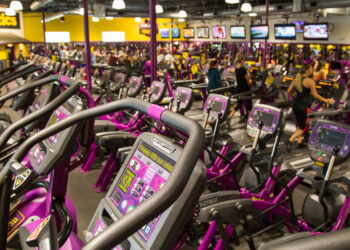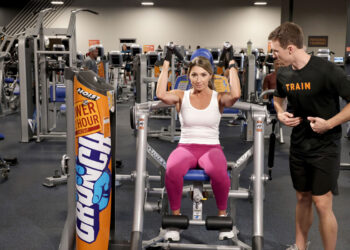As clubs swiftly approach the slow summer months, aquatic centers become a vital revenue source. Over the next several months, pools will continue to bring in outdoor-exercise enthusiasts and create a summer hot spot for children and adult members alike. By utilizing proper programs and services through the club’s aquatic zones, profits can be expected to emerge.
Over the years clubs have become increasingly more experimental with their aquatics areas. “There are many exciting new toys and pieces of equipment that can enhance the aquatics experience,” said Cheryl Jones, the vice president of programs and services for Town Sports International (TSI). “There are water slides of every shape, size and color; splash pads with ground sprays and swirling sprinklers that can make new additions to the standard spa and Jacuzzi.” Along with these new amenities, clubs have been able to entice members of all ages to enjoy the aquatics center.
“Everyone in the community needs to learn how to swim,” Jones stated. “Many families enjoy outdoor pools in the summer, so offering learn-to-swim programs and outdoor summer pool memberships are an extreme benefit to the community.” This opportunity also has prepared clubs for another necessity within the community.
As the community desires summer swimming instruction, it must also have lifeguards. By hosting lifeguard certification classes, the clubs create an opportunity to bring in quality instructors and give the club a little boost to its bottom line. Also, by hosting the certification class, it puts the club in a greater position to hire the best guards for the club’s outdoor and indoor pools.
When clubs implement aquatic zones, they must keep their options open to the public. Many clubs throughout the U.S. have started renting out, or hosting, swim clubs that bring in family memberships. The clubs should find a quality swim coach and host a swim club throughout the year. This gives parents a place to send their children and will entice them to work out while the children practice their stroke.
Making Profits
If the club can host summer events they have the ability to boost their bottom line during some slower months. “The biggest profit areas are in youth programs and summer pool memberships,” Jones said. “Management should carefully schedule their pools for lap swimming and aquacize classes that open many time slots for selling swim lessons to pre-school children in the morning and elementary school children after school.”
The staff should be hired around these different schedules and they should be vibrant and excited to work with kids. If the kids have a good time, the parents won’t have to worry about leaving them with an instructor. “All programs should aim to achieve a 40 percent profit margin,” said Ann Shaw, the director of aquatics for the Maryland Athletic Club. “Hire staff that can be used in more than one job function to help control payroll.” The President of Pfeiffer Fitness Rebecca Pfeiffer said, “Managers and staff need to think of the pool as part of the gym, as a piece of exercise equipment or as part of the studio. This will allow clubs to think of programming in a more inclusive manner.”
Children are going to be the high point of the summer and will help keep the club soaring with profits throughout the year. Although parents will want to be outside with their kids, they won’t want to watch them at every moment. This is where these types of classes with young kids will bring parents in out of the heat. “Marketing to pre-schools and inviting them to include swim lessons in their curriculum provides value to the parent and is an additional revenue source for the club,” Jones explained. “Special events like end-of-the-year school pool parties, Girl and Boy Scout swim badges and birthday parties are another very profitable area.”
“The largest aquatic programming at most locations should be a high-quality swim school with swim teams that serve both children and adults,” said Seth Hazen, the regional aquatics director for Club One.
The club should attempt to think outside the box when developing profitable programs that can keep people interested all year. “Designing specialty aquatic programming that fits the needs of your community are the next most valuable source of revenue,” Hazen said. “There are so many different types of programs from Aqua Therapy to Aqua Yoga, Arthritis programming, scuba/snorkeling, canoeing etc. Designing something that both is unique and stands out but also fits the needs of your community is the best way to maximize profits.”
Just like a pool in the backyard, the club’s pool is going to have its fair share of expenses. Of course, the idea is to make more money than expenditures. Although this can be a difficult task, if the programs are launched and marketed properly, everything should run smoothly and be profitable.
Clubs must set up some preventative maintenance and make sure employees have basic knowledge of pool upkeep. “Careful scrutiny of pool construction requirements for the population you want to accommodate is critical,” Jones said. “The structure of your ongoing pool maintenance can make or break your pool. The biggest issue is chemical balancing. Without proper and consistent balancing, the pool can become unsafe very quickly. Plus, improper balancing can lead to pool mechanical equipment failures.”
“Mechanical issues are huge and often times unavoidable, but making sure that your facilities and aquatics team are both trained and have current CPO (Certified Pool Operator) or AFO (Aquatic Facility Operator) certifications will result in any down time kept to an absolute minimum,” Hazen said. “Also, it doesn’t hurt to have an outside pool company come and check over your pump room once a quarter to help with preventative maintenance.
“You should also have a system in place where you can temporarily partner with an area pool — even if it is a competitor — to potentially send your members or programs if your closure is going to be a significant length of time.”
Jones said trying to target multiple demographics could be a major expense. She suggested clubs find a niche that they can adjust their attention to fully. If the club has a young membership, clubs may want to target children and Pre-Natal programs. However, if clubs have an older demographic, clubs may need to rethink their marketing and design of the pool.
Seniors enjoy rehab programs as well as other group classes in the pool. Jones said clubs should make sure they have enough steps for the seniors to access the pool; they can’t just jump in and start swimming. “Are there steps versus ladders in your pool,” Jones asked? “Steps allow seniors to enter and exit safely and can be used as safe swim lesson stations for younger children who are learning to swim.”
Locker Rooms
Along with targeting demographics, the clubs must think about the desires of the members that use the pool most frequently. Members don’t want to walk through the rest of the club in their swimsuits to get to the pool and back after they have been swimming.
Clubs that utilize their pools have separate locker rooms next to the pool or doors to get from the main locker room directly to the pool. “When determining the programs you would like to offer, size and layout of locker rooms should be considered,” Jones said. “Bathing suit dryers and plastic swim bags for wet suits are nice amenities.”
By having lockers constructed solely for your aquatics center, the rest of your club won’t continually stay flooded. This helps the club keep wet children and adults from rushing around equipment with wet feet. Also, by having separate locker facilities it can keep the aquatics area separate from the rest of the club facility. The members that want to use their normal workout space won’t have to deal with loads of children and parents running around all over the club.

“Safety of pool participants and ongoing pool maintenance are the most important factors,” Jones said. “Careful scrutiny of pool construction requirements for the population you want to accommodate is critical. These include deck size, pool depth, length of steps and placement of slides and/or diving boards. The structure of your ongoing pool maintenance can make or break your pool.”
Keeping the pool clean can also mean keeping it safe. One of the most important aspects of the aquatics center is safety. Clubs can’t forget the demographic that they choose to target when building a pool. Also, almost regardless of the demographic, kids will eventually find their way to the pool.
This is critical for clubs. By insuring the cleanliness of the facility and the lack of water distributed around the dry decks, clubs can also make sure kids don’t slip and fall. Also, many times, lifeguards aren’t always on post in the club’s aquatic area. Make sure the club posts signs warning children and parents about the risk of swimming without a lifeguard. However, make sure you have trained staff to know how to react in a water emergency.
The aquatics center can be a great addition to the club. Not only does it provide another area for members to exercise, but it can also boost the club’s bottom line throughout the year. Make sure to focus on the pool’s development, but continue the upkeep, programming and marketing for additional club profits. -CS










